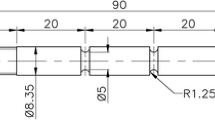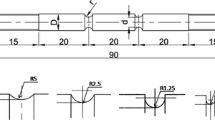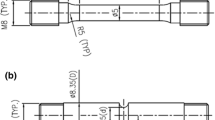Abstract
In this investigation, detailed finite element analysis has been carried out to assess the creep behaviour of 9Cr-1Mo and modified 9Cr-1Mo steels under multiaxial state of stress. The multiaxial state of stress was introduced by incorporating the circumferential notches of different notch radii in smooth cylindrical specimens. The creep experiments were carried out on smooth and notched specimens of the steels at 873 K and in the stress range of 110–230 MPa. The modified 9Cr-1Mo steel possessed significantly higher creep strength than the 9Cr-1Mo steel. The rupture life was found to increase in presence of notch for both the steels. However, the extent of strengthening was found to be significantly higher for modified 9Cr-1Mo steel compared to 9Cr-1Mo steel. The fracture appearance was found to be dependent on the applied stress and the notch geometry. Typical transgranular ductile fracture was observed for shallow notches and mixed mode fracture consisting of ductile and creep cavitation for relatively sharper notches, which was more prevalent at lower applied stress. Finite element analysis was carried out to understand the distribution of stresses across the notch throat plane. The stresses were found to relax in the notch throat plane. The stress relaxation at the notch root was found to be more for modified 9Cr-1Mo steel than that of 9Cr-1Mo steel, resulting in higher extent of strengthening in modified 9Cr-1Mo steel.
Similar content being viewed by others
Avoid common mistakes on your manuscript.
1 Introduction
Good thermo-physical properties, high temperature oxidation resistance and mechanical properties and cost effectiveness are the main reasons for selection of ferritic steels as a structural material for steam generators of Prototype Fast Breeder Reactor (PFBR) at Kalpakkam, India and fossil power plants and heat transport systems. Continual drive to increase operating temperatures of conventional fossil-fired power plants to increase thermal efficiency and reduce CO2 emission led to the development of modified 9Cr-1Mo steel with higher creep resistance by adding V and Nb in 9Cr-1Mo steel [1]. The components operating at relatively high temperatures experiences creep deformation and damage. Generally the components are designed based on the uniaxial creep data. However, the components experiences complex multiaxial state of stresses as a result of geometrical [2] or metallurgical constraint [3]. One of the promising techniques of carrying out creep under multiaxial state of stress is by introducing notches of different notch geometries [4–12]. Different shapes and depth of the notch generate variation in multiaxial state of stresses in the notched specimen. The material may exhibit notch strengthening or weakening depending on the material’s deformation characteristics, notch geometry and depth of the notch. Hayhurst et al. [4–6] carried out detailed analysis of notched specimens under multiaxial state of stress. Goyal et al. [7–9] studied the effect of notches on creep behaviour of 2.25Cr-1Mo steel and observed notch strengthening. The studies carried out on alloy X-750 by Pandey et al. [10] reported notch strengthening in the material for the testing conditions. The cracking in the specimens was found to shift systematically from centre of notch at the high stresses towards notch root at lower stresses. Webster et al. [11] studied notched specimens of beta processed titanium alloy Ti5331s and observed notch strengthening in the material. Similar observations were made by Kwon et al. [12] on 2.25Cr-1Mo and Durehete 1055 steels.
Though there have been extensive analysis of stress distribution across the notch, the corroboration with experimental data is scarce. In this investigation, the assessment of rupture behaviour has been made by incorporating notches of different notch radii in 9Cr-steels. The strengthening observed in the steels has been explained based on the stress distribution across the notch.
2 Experimental
In the present investigation, creep behaviour of 9Cr-steels in presence of notch has been studied. Chemical composition of the steels used in given in Table 1. The 12 mm thick plates were received in normalized and tempered heat treated condition. Creep tests were carried out on smooth and notched specimens of the steels at different stresses ranging from 110 to 230 MPa at 873 K. The net applied stress at notch throat plane was same as that of applied stress in the case of smooth specimen. Circumferentially U-notches of different notch root radii, keeping the minimum diameter of the specimen similar to smooth specimen, were introduced in the cylindrical specimens of the steels, Fig. 1. Two equidistant circumferential notches, 20 mm apart, were introduced so that un-failed notch can be used for cavitation measurements.
Finite element analysis of stress distribution across the notch throat plane during creep exposure was carried out to understand creep rupture behaviour of the notched specimens. 2D axisymmetric analysis was carried out due to geometrical and loading symmetry, using quadrilateral elements employing ABAQUS 6.10 finite element solver, Fig. 2. Earlier studies have revealed that the local plastic deformation around the notch root in the initial loading does not influence the stationary state creep stresses in the notch throat section [13]. Considering this fact, the present investigation has been carried out only with elastic-creep behaviour. The analysis was carried out implementing elastic deformation followed by creep deformation using Norton’s creep law of the materials. The mesh was refined at and near the notch root and elastic analysis was carried out to ensure that the mesh configuration was sufficiently refined to predict the theoretical elastic stress concentration factor at the notch root [14]. The stress redistribution is generally considered to attain stationary state condition when the total strain at the notch throat plane reached the elastic strain in the material as proposed by Calladine [15].
3 Results and Discussion
Creep tests were carried out on smooth and notched specimens at different stresses ranging from 110 to 230 MPa at 873 K. The Norton’s law \(\left( {\dot{\varepsilon }_{s} = A\sigma^{n} } \right)\) coefficients obtained from the creep tests on smooth specimens of the steels are given in Table 2. The variation of rupture life of the smooth and notched specimen of the steels for notch root radius of 1.25 mm is shown in Fig. 3. The modified 9Cr-1Mo steel exhibited higher creep rupture strength than that of 9Cr-1Mo steel. The creep rupture lives of the steels in the presence of notch were found to be higher than those of the smooth specimens, exhibiting strengthening in the presence of notch in both the steels. The extent of strengthening was found to be higher for modified 9Cr-1Mo steel than that of 9Cr-1Mo steel. Both the steels showed saturating trend in strengthening with decrease in notch root radius for a given applied stress, Fig. 4. The fracture appearance was found to be dependent on the applied stress and the notch geometry. Typical transgranular ductile fracture was observed for shallow notches (Fig. 5) and mixed mode fracture consisting of ductile and creep cavitation for relatively sharper notches, which was more prevalent at lower applied stress (Fig. 6).
Creep strengthening observed in the steels in presence of notch (Fig. 3) and effect of notch sharpness on the extent of strengthening (Fig. 4) have been assessed based on the FE analysis considering the Norton’s law as material models for the steels. The stresses were found to redistribute due to the variation in creep rate across the notch throat plane. As a result, the stress relaxation takes place at the notch root and the stresses decreases much below the net applied stress especially for relatively sharper notches. The stress relaxation for net applied stress of 210 MPa at the notch root for two different notch root radii (1.25 and 0.5 mm) for the steels is shown in Fig. 7. The time for relaxation has been normalized with the time to reach stationary state for the steels. The stress relaxation was relatively faster for modified 9Cr-1Mo steel especially for sharper notches than that of 9Cr-1Mo steel.
Creep fracture in presence of notch depends on the different components of stresses viz., maximum principal stress, hydrostatic stress and von-Mises stress in governing the creep deformation and cavitation. The von-Mises stress controls the deformation and creep cavity nucleation processes whereas, the maximum principal and hydrostatic stress control the continuum cavity growth [16].
The extent of notch strengthening has been explained based on the variation of von-Mises stress with notch acuity ratio (ratio of notch throat diameter to notch root radius). The von-Mises stress remained below the net applied stress after stress redistribution (Fig. 8) for all the notch acuity ratios and resulted in notch strengthening as observed experimentally (Fig. 3). The decrease in von-Mises stress (which is the effective stress under multiaxial state of stress) led to higher notch strengthening with increase in notch acuity ratio. The saturating tendency of von-Mises stress with increase in notch acuity ratio would have been the cause for saturation of notch strengthening at higher notch acuity ratio.
For shallow notches, the uniform von-Mises stress across the notch throat plane (Fig. 8) is expected to induce cavities uniformly and higher maximum principal and hydrostatic stress at the centre (Fig. 9) would result in growth and failure resulting in ductile appearance. However, for sharper notches, higher von-Mises stress at the notch root (Fig. 8) is expected to induce cavities there and higher maximum principal and hydrostatic stress near notch root (Fig. 9) would result in growth of nucleated cavities. The creep crack (brittle in nature) then further grows towards centre and under instability fails at the centre resulting in ductile appearance at centre of notch. It is interesting to note that the stresses were higher for 9Cr-1Mo steel compared to modified 9Cr-1Mo steel resulting in early failure and lesser extent of creep cavitation.
In the present investigation, notch strengthening has been observed in the steels. However, under certain circumstances, depending on the material’s deformation characteristics, notch geometry and net applied stress, the material may exhibit notch weakening also. The FE analysis would give the distribution of stresses across the notch throat plane depending on the notch root radius. Earlier studies carried out by Hayhurst and Webster has revealed that as the notch root radius is decreased, the hydrostatic stress shows a continuously increasing trend whereas; von-Mises stress showed decreasing but saturating trend [17]. The decreasing trend in von-Mises stress would result in increase in rupture life while the increasing hydrostatic stress would enhance the cavity/void growth rates and may result in notch weakening. Similar observation has been reported by Al-Faddagh et al. and Goyal et al. in 2.25Cr-1Mo steel [8, 18]. In addition to that, as the notch root radius is decreased, the material may exhibit notch weakening. The presence of very high axial stress may result in cracking at the notch root at early stage and may exhibit notch weakening.
4 Conclusions
Following conclusions have been drawn based on the studies on the effect of multiaxial state of stress introduced by notches on creep rupture strength of 9Cr-steels:
-
1.
Presence of notch increased the creep rupture strength of the steels. The creep rupture strength of the steels increased with decrease in notch root radius and tends to saturate for higher notch sharpness.
-
2.
The extent of strengthening was found to be higher for modified 9Cr-1Mo steel than that of 9Cr-1Mo steel.
-
3.
The FE analysis revealed the relaxation of stress below the net applied stress resulting in notch strengthening.
-
4.
The extent of stress relaxation decreased with notch radius resulting in saturating trend in notch strengthening in both the steels.
References
Klueh R L, and Harries D R, High-chromium ferritic and martensitic steels for nuclear applications, American Society for Testing and Materials, West Conshohocken, Pennsylvania (2001).
Gooch D J, and How, I M, Techniques for Multiaxial Creep Testing. Elsevier Applied Science, Amsterdam, (1986).
Goyal S, Laha K, Chandravathi K S, Parameswaran P, and Mathew M D, Philos Mag 91 (2011) 3128.
Hayhurst D R, J Mech Phys Solids 20 (1972) 381.
Hayhurst D R, Leckie F A, and Henderson J T, Int J Mech Sci 19 (1977) 147.
Hayhurst D R, Henderson J T, Int J Mech Sci 19 (1977) 133.
Goyal S, Laha K, Das C R, Panneer Selvi S, and Mathew M D, Mater Sci Eng A 563 (2013) 68.
Goyal S, Laha K, Das C R, Panneer Selvi S, and Mathew M D, Int J Mech Sci 75 (2013) 233.
Goyal S, Laha K, Vijayanand V D, Panneerselvi S, and Mathew M D, Procedia Eng 55 (2013) 510.
Pandey M C, Mukherjee A K, and Taplin D M R, J Mater Sci 20 (1985) 1201.
Webster P S, and Pickard A C, J. Strain Anal 22 (1987) 145.
Kwon O, Thomas C W, Knowles D, Int J Press Vessel Pip 81 (2004) 535.
Goyal S, Laha K, and Mathew M D, Metall Mater Trans A 46 (2015) 205.
Pilkey W D, and Pilkey D F, Peterson’s Stress Concentraton Factors, 3rd edn. Wiley, Hoboken (2008).
Calladine C R, Proc R Soc Lond A 309 (1969) 363.
Nix W D, Earthman J C,Eggeler G, and Ilschner B, Acta Metall 37 (1989) 1067.
Hayhurst D R, and Webster G A, in Techniques for Multiaxial Creep Testing, (eds) Gooch D J, How I M, Elsevier Applied Science, Amsterdam (1986), p 137.
Al-Faddagh K D, Webster G A, and Dyson B F, in Mechanical Behaviour of Materials IV, (eds) Carlsson J, Ohlson N G, Pergamon Press, Oxford (1984), p 289.
Author information
Authors and Affiliations
Corresponding author
Rights and permissions
About this article
Cite this article
Goyal, S., Laha, K. Assessment of Rupture Behaviour of 9Cr-Steels Under Multiaxial State of Stress. Trans Indian Inst Met 69, 445–450 (2016). https://doi.org/10.1007/s12666-015-0786-3
Received:
Accepted:
Published:
Issue Date:
DOI: https://doi.org/10.1007/s12666-015-0786-3













